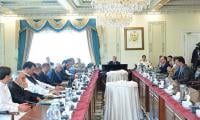With the budget session due, it may be pertinent to examine the issue of budget priorities. In the past, the budget design was essentially seen as an accounting exercise aimed at balancing existing expenditures with revenues and controlling the budget deficit within a tight ceiling specified by the IMF.
Economic initiatives were limited to tinkering at the margin and budgetary allocations caught in the time warp of the past. It is time now to think outside the rigid mould of economic orthodoxy. The budget design should be based not on simple accounting but on an imaginative economic strategy.
Allocations of public expenditures arising out of the new economic strategy should provide the financial muscle to new initiatives that can achieve two inter-related objectives. First, equality of opportunities for all the citizens, rather than only for the elites; and second, placing Pakistan on the path of sustainable development. Both these objectives require a quantum leap forward towards the universal provision of education and health.
Recent research has shown that health and education are not just ‘social sectors’ to be dealt with on the margins of a growth policy as economic orthodoxy would have has believe. Rather, education and health are the key determinants of long term sustained economic growth. At the same time contrary to conventional thinking, equity is not just an imperative of justice but is crucial for economic growth.
My own research, conducted with my graduate student and now research assistant Nazeef Ishtiaq, analysed data from 130 countries over two decades. Our empirical analysis showed that equity as well as health and education were the most important determinants of long-term economic growth. In a sense it is obvious: if the labour force of a country is educated, skilled and healthy its productivity and hence long term economic growth would be high.
Earlier studies on human development by Khalid Malik and others at the UNDP have shown that high ranking on health and education status is good for growth and for society.
Research by William Easterly and earlier by Dani Rodrik has shown that the greater the social cohesion of a society the higher its long-term economic growth. Now the universal provision of health, education and equity, it can be argued, facilitate social cohesion by giving all citizens a stake in such a politico-economic system. It is for this reason that Europe and some of the Asian countries which have achieved long-term growth in per capita incomes, have given a commitment to the universal provision of basic services such as health, education and social protection. For example, Germany under Bismarck in the 18th century, Japan under the Meiji dynasty in the 19th century, the Scandinavian countries and Britain in the twentieth century and then of course China in the mid-20th century.
It is clear that, based on the latest research, quality health and quality education for all citizens can play a vital role in a strategy of long term growth. In Pakistan we have still not placed the economy on a trajectory of sustained long-term growth. In this context it should give our budget-makers pause to think: our health and education expenditures by international comparison are abysmally low.
For example, public expenditures on health in Pakistan are only 0.92 percent of the GDP. Our rankings drawn from WHO data show that Pakistan is at the second lowest, ranked 191st out of 192 countries. Our ranking based on public expenditure on education as a percentage of GDP is also unenviable. Pakistan’s public expenditure on education as a percentage of GDP is 2.1 percent, which ranks us at 164th country out of 173 countries. This education figure is also the lowest in South Asia.
It is clear that if Pakistan is to pull out of underdevelopment and get onto the path of sustained high economic growth it must take a qualitative jump, not a marginal increase in its expenditures on education and health. Over 25 million children are still out of school, and those who do get a school education get such poor quality education that their ability for creative thinking remains underdeveloped. When a few of them get into universities in Pakistan, in most cases their potential for critical thinking and scholarship never sees the light of day.
The state of health should also be a matter of serious concern. My research for the first national Human Development Report of the UNDP had showed that 65 percent of the respondents we interviewed were sick and had been so for, on average, three months of the year. The US Department of Health and Pakistan Medical Association survey gave a higher figure for illness at 73 percent of the population.
There are hundreds of universities in Pakistan, but not a single one is amongst the top 100 universities of the world. Like schools, most universities in our country operate on shoestring budgets. They are unable to hire world class teachers, have extremely poorly equipped libraries and inadequate IT facilities. When students give four of the best years of their lives and a lot of money in fees to universities, in most cases they do not experience the joy of intellectual discovery. They end up with degrees that have no value in the rest of the world.
Pakistan has an institutional structure and budgetary priorities which banish most citizens to the darkness of intellectual underdevelopment. This lies at the suffering heart of our economic underdevelopment. Time to think afresh. Time for a budget design for development rather than underdevelopment.
The writer is a professor of economics at the Forman Christian College University, Lahore.
Email: akmalhussain@fccollege.edu.pk
People stand in line up as election officials check their ballot papers during voting general election at a polling...
Women show their voter identity cards as they stand in a queue before casting their votes in Agartala. — PTIThe 18th...
Former prime minister Imran Khan. — Instagram/ imrankhan.ptiAn old saying has it that “when you dance with the...
Kashmiris in Indian illegally occupied Kashmir protesting against the Indian occupation as the forces of India looked...
A representational image showing residents walking at a wholesale market in Karachi. — AFP/FileOnce again there is...
A representational image showing late Pakistani human rights activist and Supreme Court lawyer Asma Jahangir. —...







